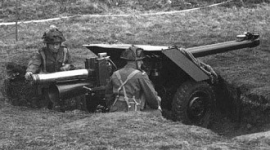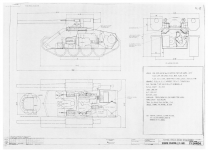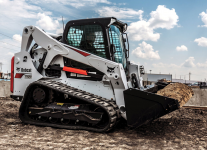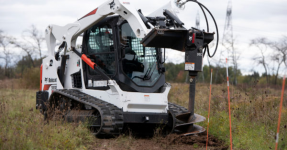- Reaction score
- 16,463
- Points
- 1,160

Absolutely. In Europe in 1945, each division had an RCA anti-tank regiment of four batteries each. In addition each of the two corps had an additional anti-tank regiment, for a total of seven regiments or 28 batteries overseas. Between them they had 150 towed and 150 self propelled 17 pdr anti-tank guns.Question for the gunners:
During World War II were there not Anti Tank regiments made up of gunners?
The 106 RR with a Laser would likely still be a fine weapon for the COIN fight, dirt cheap to operate and easy to train on. Not to mention quite portable. Compliment it with LAW's, Carl G, mortars, Grenade launcher and ATGM's and your force has a lot of organic firepower.
Not quite. The 1945 artillery organization in Europe was like this:So, the Division had 4 Regiments of 25 pdrs and 1 regiment of 17 pdrs. 3 regiments of the 25 pdrs were in Direct Support, one was in General Support and the 17 pdrs were for Close Support at the discretion of CRA?
When we got the 105mm what would have happened if the 5 Regiment format was retained (6 if the Anti Air Regiment was included)? One bullet. One gun. Many tasks. Enough guns that one of the regiments could be tasked to the Anti-Tank role or revert to the GS role.
In 1987 or so a WO had this very idea. A laser mounted on a 106.The 106 RR with a Laser would likely still be a fine weapon for the COIN fight, dirt cheap to operate and easy to train on. Not to mention quite portable. Compliment it with LAW's, Carl G, mortars, Grenade launcher and ATGM's and your force has a lot of organic firepower.
When the Chinese attacked the Americans for the first time in Korea and overran them, the 105mm M101 was used in the AT role, they did decently against T34/85's till they ran out of HEAT, the HE did minimal damage.Seen.
On the other hand, converting the ATk Regiments to 105s, along with the Fd Regiments, would still have left the CRA with a discretionary regiment that could either be held back for General Support or pushed forward as an ATk line.
Justification for retaining the number of tubes despite the fact that the tubes were more General Purpose tubes than specialized.
To give credit where credit is due, those initial victories were not by the Chinese, they were by the Korean People’s Army — North Korea had great success using the T-34/85 during the early months of the Korean War. The Chinese, on the other hand, made minimal use of tanks in Korea — but their light infantry based forces were quite successful in their own right.When the Chinese attacked the Americans for the first time in Korea and overran them, the 105mm M101 was used in the AT role, they did decently against T34/85's till they ran out of HEAT, the HE did minimal damage.
if you updated the M106RR with modern construction, optics, and ammo, just like the new M4 Carl G, I imagine it would preform very well. Have it dismounted with a command wire and camera, and it could probably be set up in some pretty deadly ambushes against light armoured vehicles, maybe even heavy armour depending on what modern ammunition could pull off.In 1987 or so a WO had this very idea. A laser mounted on a 106.
A fire and forget projectile - shoot n scoot.
I saw that at an arms show in Ottawa in about 1993. Pretty neat idea.In 1987 or so a WO had this very idea. A laser mounted on a 106.
A fire and forget projectile - shoot n scoot.

The L1 BAT is the original version of the BAT recoilless rifle. The name BAT stands for Battalion Anti Tank. The BAT is very unusual as it features a large two wheel carriage with a gun shield as if it were an anti-tank gun. Due to the weight the BAT must be towed by truck. Many original L1's have been converted to the L4 MOBAT by removing the shield and adding a ranging machine gun.

The L6 WOMBAT is a lightweight model of the BAT for use by mobile units such as paratroopers or marines. WOMBAT stands for Weapon Of Magnesium BAT, referring to the use of magnisium alloys to reduce weight. Instead of a 7.62mm Bren a 12.7mm M8C (L40A1) ranging machine gun is fitted. The WOMBAT is fitted on a lightweight carriage with two small wheels. It is usually mounted on a Land Rover and some have been mounted on a FV 432 tracked APC. The Royal Marines used a Snowcat during operations in Norway. The WOMBAT is the latest version of the BAT and was the last version to remain in UK service.
The BAT fires only a single type of ammunition, the 120mm L2 HESH round. The HESH round is effective against both armored vehicles, enemy positions and infantry. The ammunition is of the seperate loading type with the first part being the shell and the second part the metal casing with propellant. It is reported that smoke, illum and training rounds were developed but only used in very limited quantities.
- Specifications:
- L2 HESH
Category Recoilless rifle round Type HESH Diameter 120 mm Length ? Weight 12.8 kg projectile, 27.2 kg complete round
Charge 4.5 kg propellant Warhead HESH Fuze ? Effects 400mm RHA Velocity 462 m/s at muzzle
Range 800 m effective, 1.6 km max Accuracy ? Tracer - Remarks -
Next level up would be the 120mm Battalion Anti Tank guns, recognizing that the efficacy of the HEAT/HESH rounds is directly related to the calibre (diameter)
Only trouble is that the weight of the round increases to 50 lb or 27 kg. On the other hand the projectile increases in mass to 12.8 kg
The L1 was designed to replace both the 3.45" Recoilless and the 17 pdr AT Gun
View attachment 66226
View attachment 66227
It eventually morphed into the L6 WOMBAT ("Weapon Of Magnesium" Battalion Anti Tank) by the 1980s





Not without a huge amount of engineering. Completely different ignition systems, right down to where the electrical connections are. You would have to mount the CLU on a vehicle or outside a bunker as you don't want a human anywhere near a CRV 7/Hydra 70 when it launches. It's not impossible, but one of the main problems I've seen with procurement of any system these days is the tendency to make it too complex and perform all the tasks rather than have specific tools. I don't believe it is any more expensive in procurement to get discrete systems, training and PY costs would be greater.Which opens the possibility of compatibility with the 70 mm APKWS
Which opens the possibility of compatibility with the 70 mm CRV7
Not without a huge amount of engineering. Completely different ignition systems, right down to where the electrical connections are. You would have to mount the CLU on a vehicle or outside a bunker as you don't want a human anywhere near a CRV 7/Hydra 70 when it launches. It's not impossible, but one of the main problems I've seen with procurement of any system these days is the tendency to make it too complex and perform all the tasks rather than have specific tools. I don't believe it is any more expensive in procurement to get discrete systems, training and PY costs would be greater.
This highly mobile system mounted on the WIESEL vehicle is used to protect light forces against threats from the air. The launcher, which is suitable for a very wide variety of guided missiles, can also be integrated on other vehicles.
Designation: LEFLASYS/ASRAD
Manufacturer: Rheinmetall Defence Product type: Armoured Vehicles Name: Anti-aircraft system
System elements
• Fire unit "OZELOT"
• Platoon Command Post (PCP)
• Battery Command Post/Coordination Cell Air Defence
• Air defence interface vehicle
• Workshop equipment
Main Features
• 24-hour battlefield day with active and passive sensors for all climatic zones
• High mobility, air transportability in transport helicopters
• Sufficient degree of operator protection
• Easy operation due to automation, low manning and training requirements
• Low logistic effort, minimum life cycle costs (LCC)
• Extreme flexibility through deployment of different GM-systems (e.g. Stinger, Igla, RBS 70, Bolide etc)
• Connection to national and Nato command post organisations
Light Mechanized SHORAD System "LeFlaSys" is in series with the German Army.
Bv206S – Lightly armoured air-portable all-terrain vehicle

The Bv206S is a high-mobility, lightly armoured, air-portable vehicle consisting of separate front and rear sections. These are connected and steered by a hydraulic articulated transmission and swivel joint. Owing to its steering system and wide rubber tracks, the Bv206S assures excellent mobility even in the toughest terrain. The German Bundeswehr operates several versions of the Bv206S, configured for medivac, mobile surgical, armoured personnel carrier and tactical operations centre roles.
